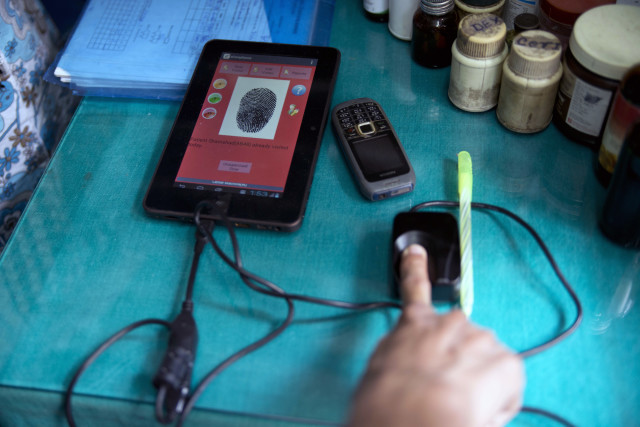Biometrics might be the future of security in cyberspace, but in India, a non-profit is using the technology to help health workers fight tuberculosis (TB).
Operation ASHA, a group dedicated to bringing tuberculosis treatment and health services to India’s urban slums and rural villages, has adopted biometrics to ensure that TB patients receive full treatment and to detect any new cases.
To accomplish this, the group uses an array of tools called eCompliance, eDetection and Lab Alert System.
“TB patients are hidden in darkness, partly due to their own fears of death and disease, and partly due to fear of discrimination” – Dr. Shelly Batra
Operation ASHA President and Co-Founder Shelly Batra, MD, explained how all this works in an email interview.
Q. How does eCompliance work?
BATRA: TB patients must take up to 76 doses of medicines under direct observation. Patients must visit a designated treatment center for this. This poses a challenge for all stakeholders – the patient, health workers and supervisors – due to [the] long six-month time period involved.
… Operation ASHAs centers are based deep in disadvantaged areas, and open at convenient times so no one has to miss work and wages .eCompliance was developed to further ensure every dose [is] taken at these centers, and for tracking patients who miss their dose.

A tuberculosis patient scans his fingerprint into Operation ASHA’s system to register his clinical visit and compliance with required treatments. (Prateek Ahuja)
eCompliance software is loaded on a 7” tablet, which has a SIM card. This connects the tablet to a central server through internet or text messages … The tablet connects externally with a biometric finger printing device.
… Once a patient is diagnosed with TB, his fingerprints are registered in the system alongside his other details. Thereafter, every time the patient takes the medication, he has to give his fingerprints at the TB treatment center. This generates irrevocable evidence that the visit took place, every time, and the medicine was taken under observation.
If a dose is missed, eCompliance issues an alert to the patient, health worker and his supervisor. The health worker has to meet the patient within 24-48 hours, provide further counseling, deliver the dose and ensure that the patient re-joins the therapy … This helps achieve a very high adherence and treatment success rate.
Q. When did you start using this tool?
We piloted eCompliance in Delhi, India, in 2009 and have now scaled to most of our centers in India in nine states.
It has already recorded over 450,000 transactions with a treatment completion rate of almost 90 percent and an extremely low default rate of below three percent.
In Cambodia, we are serving 10 percent of all TB patients and the population … eCompliance has been replicated in Uganda and the Dominican Republic, and now in Peru by third parties. In Afghanistan, we are collaborating with a local NGO who wants to learn and implement eCompliance and have already received funds for doing this knowledge exchange and buying hardware.
Q. What is eDetection?
BATRA: Due to the high proportion of ‘missed cases’ of TB, OpAsha introduced eDetection to its technology suite. It is used to scale up detection of these unidentified and hidden patients in hard to reach geographies, where delivery of government healthcare system is fractured. It is also used to screen contacts of existing patients. TB patients are hidden in darkness, partly due to their own fears of death and disease, and partly due to fear of discrimination.
… OpAsha’s community health workers … use eDetection to educate the community on symptoms of TB, administer an algorithm-based questionnaire, and subsequently facilitate sputum testing and diagnosis of suspects based on the responses to the questionnaire. Thus use of eDetection ensures early screening and identification of TB patients, enrolling them for treatment and also reducing the spread of infection to other individuals.
… Results from our pilot study in Cambodia show a substantial increase in identifying symptomatics and a 20 percent increase in detection rates of TB patients in comparison to manual detection, as compared to data during the same period in the previous year. There is a 20 percent Improved detection, 20 percent improvement in productivity, and 20 percent reduction in costs.
Q. How does the Lab Alert System work?
BATRA: This is simply a system where manual lab registers are replaced with electronic ones … End-Users [mainly lab technicians] enter contact details of patients along with [their] lab result … So whenever a patient tests positive for TB, an SMS gateway sends text messages to the concerned health worker, who follows up with the patient, carries out intensive counseling and ensures that the patient is promptly enrolled for treatment.

One response to “Using Biometrics to Track India’s Tuberculosis Cases”
I am very impressed by this article. How do we go about accessing this technology. I am in South Africa, however we only want to use this tool to register people on our household registration database.
For the moment the challenge is undocumented people and with this tool we can simply bypass the efect of no documentation as this tool creats a unique identifier for every person in a particular community